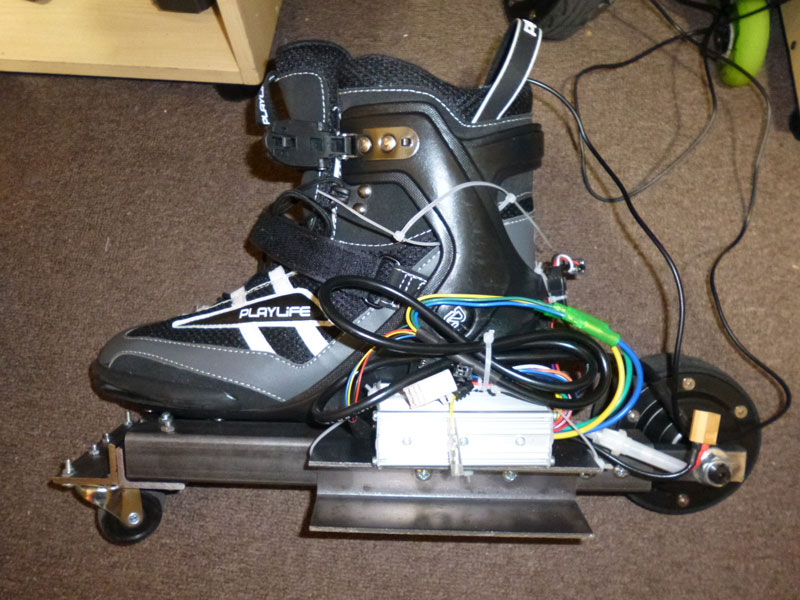[Harris] has an interesting answer to the inevitable question about what he did on his summer vacation: he built a pair of electric roller blades. [Harris] is an Electrical Engineering student at the University of Nottingham, and he completed the first version of what he calls Skelecs just before he went back to college. He has documented the process from the initial concept and building his own controller board, through his failures at correctly drilling the steel base, to his first drive down the road.
His build uses a pair of small 120W hub motors attached to a steel chassis, which is attached to a pair of cannibalized rollerblade boots.
It’s a bit of a Frankenstein build (he currently has the batteries and controller stuffed into a pants pocket, which isn’t really a practical long-term solution), but it works. A bit too well, in fact: [Harris] says that a combination of speed and a bumpy road detached one of the batteries and sent him flying. He’s not letting a minor injury and a bit of blood put him off, though: he’s already started work on version 2, which will use lighter aluminum construction and a pair of omniwheels for easier steering and more control. We’ll believe that claim when we see it.
Remember, powered skateboards are over — non hackers got their hands on them so they’re commonplace. Hipster hackers need to drop that build and start on your own pair of Skelecs.















Shout out to the wile e coyote tag because this is as close as you can get to strapping rockets to your boots without using rockets.
Because jet engines and having neighbors usually don’t mix :D
It’s about as safe as this:
http://cr4.globalspec.com/comment/326121/Re-Motorized-Roller-Blades
If only it wasnt filmed in the middle of the night!
It would be great to actually see the product :)
I know what I want for Christmas…
Two broken kids scooters some LiPo batteries and a couple of days off work.
More evidence that electrical engineers should consult with mechanical engineers before designing anything.
I agree. Those small diameter casters in the front are just waiting to dig into the first seam in the sidewalk and trip you.
Seems like he could solve that by lengthening the steel beams by about 8 inches each front and back.
update, didn’t see the casters – that’s a problem – I wonder if he could hack one of the original rollerblade wheels back in.
In the video the caster wheel was at the back, which wouldn’t be a problem.
I have seen DIY skeelers with two variable-speed cordless drills driving the rear wheels through a right-angle gear. Sadly, I can’t find any images of it now.
I saw Jamie from Mythbusters using that setup in an old Battlebots episode (forgot which season).
That’d be a way safer/easier hack, imo.
Huh. I think if I were to try it I might stick with the original rollerblade wheels and add the hub motor as a clamp-on that would just sit behind the original wheels. Then just steer tractor style.
Benefits:
————-
Reversible
The wheels on rollerblades have good bearings and are meant to be on rollerblades
Easily transferable between skates
Less overall weight
Specially if the rollerblades have detachable break pad assemblies. Reuse these mountings, what is strong enough for braking will also be for propulsion.
“omniwheels for easier steering and more control”
Never seen that happen before. It could make it more like ice skating, without the blades.
It would be like trying to turn a car on ice. Seems he would have absolutely no control, and at some point would probably end up getting his feet too far apart and wouldn’t have the strength to recover in a non painful way.
Especially since driven omniwheels put force at on both the x and y directions, if there is no rigid attachment to a wheel on the other side he will be driven sideways (maybe in opposite directions) just as much as forwards.
wouldn’t that be a mecanum wheel?
Like some others, I think the casters are troubling. To me, it seems like they were employed to enable steering steering without lifting the skate; which would probably lead to uncontrolled acceleration of the drive wheel. Why did [Harris] not just employ an accelerometer or a strain gauge in each boot to detect when the foot has been lifted?
or sense the motor current and throttle back the frequency when you detect the absence of a load.
Or both.
I have to agree with RandyKC. It’ll become even closer to walking on ice, especially if power is lost. I’d try a variation on Chuck’s original design, which is closer to a traditional rollerblade.
http://www.etotheipiplusone.net/?cat=63
Frankly, a separate drive module that make ground contact when either leaned forward or backward on (that’s a design decision, not a try both option) would be safer to implement on standard rollerblades and allow you to transition back to normal skating motion in case of a failure. This would keep your weight over the full contact skate and put less weight on the driven one, so if it suddenly stops or accelerates, you have a greater chance of maintaining your balance.
Those look amazing.
could use a skateboard truck in the front if you’re gonna go full-[custom]. don’t ever go full-[custom] though. thats when you start filming at night n stuff
A lot of this hardware looks familiar ^o^
Dewalt 20 volt angle grinder, swich the cutting wheel out for a scooter wheel, open her up and put a length of wire between the grinder and the potentiometer it came with so you have a remote, ziptie that fkkr to your skate.
Bada bing bada boom.